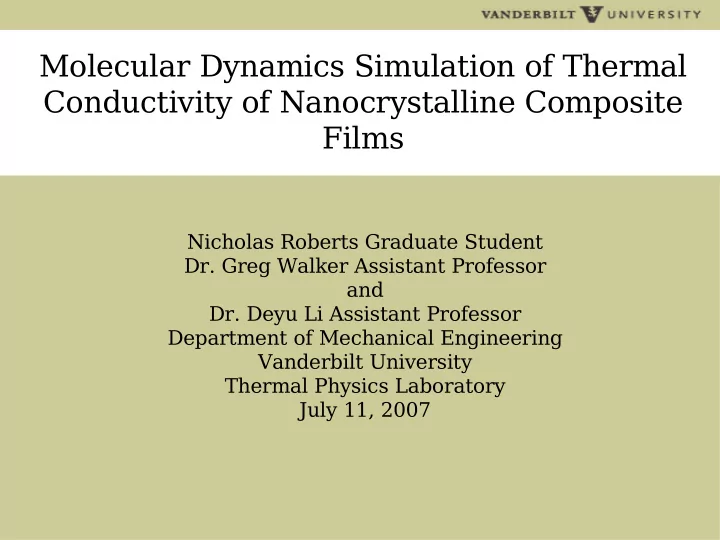

Molecular Dynamics Simulation of Thermal Conductivity of Nanocrystalline Composite Films Nicholas Roberts Graduate Student Dr. Greg Walker Assistant Professor and Dr. Deyu Li Assistant Professor Department of Mechanical Engineering Vanderbilt University Thermal Physics Laboratory July 11, 2007
Motivation Nanostructured devices possess desirable characteristics for solid state energy conversion Density of States (1/eV) 3D 1D 2D E – E c (eV) ZT=S 2 σT / k nel-8.case.edu/personal/research.html q 2
Computational Model V r ij = 4ε [ ] •Using a Molecular Dynamics Code to calculate the r − r 12 6 σ σ effective thermal conductivity of a composite material •Argon/Krypton FCC domain, wall and bath •Boundary Conditions are constant temperature for q= − kA ΔT boundaries orthogonal to transport and periodic parallel to transport L •Calculates flux between planes using approach outlined by Ikeshoji and Hafskjold, Molecular Physics (1994) T H = 60K q T C = 40K 3
Simulations Single Crystal Checkerboard •8x8x8, 16x8x8, 32x8x8 and 16x16x16 FCC UC domains •Varied the simulation parameter (crystal size, block size or number fraction) Random Argon Distribution Krypton “alloy” 4
Analytic Model k eff = [ +γA S ] − 1 1 − n Kr n Kr k Ar k Kr •Smooth transition from primary to secondary •Thermal conductivity minimized when interface is maximized 5
Random Distribution of Atoms •50% atomic number fraction has the lowest thermal conductivity of all configurations being 0.49 for 8x8x8 •Greater reduction of thermal conductivity found in larger simulations (Maximum of 59% achieved in 32x8x8 case) •This is assumed to be the alloy limit for Argon/Krypton 6
Constant Number Fraction Results •Thermal conductivity is reduced by decreasing the period of “blocks” •Greater than 50% reduction •Optimal period length in larger domains •16 UC lengths include longer wavelength phonons 7
Constant Interface Area Results •Constant interfacial area of 64 UC 2 •No interfacial area at number fractions of 0 and 1 (interface not within domain) •Reasonable agreement with model, same fit parameter as in single crystal 8
Single Crystal Results •Conductivity increases with increasing fraction of Krypton atoms beyond inscribed sphere •Interface dominates thermal conductivity •Decreases until the crystal becomes an inscribed sphere 9
Argon Krypton Switch •Lower thermal conductivities found when the crystal was composed of the heavier material (Krypton) than when composed of the lighter material (Argon) •Greater reduction found when the crystal was composed of the lighter material 10
Summary of Results •Much greater reduction in thermal conductivity in the checkerboard cases over single crystal •Conductivity is related to interfacial area Device Min k eff /k Ar Parameter n Kr = 0.5 alloy 0.49 l p = 4 UC 0.52 x = 8 UC 1.00 r = 4 UC 0.85 11
Conclusions •Single crystal results were comparable to observations from the literature •Single crystal should be as large as possible within the domain to maximize interfacial area •Embedded material of lower conductivity adds to effect of interface 12
Acknowledgements Dr. Yunfei Chen, Southeast University, Nanjing, China This work is supported by NSF under award number CBET-0731101 13
Recommend
More recommend